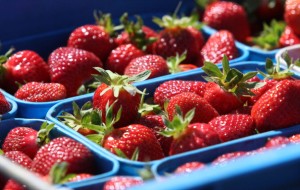Buying Organic on a Budget: New Shopping Guides Rank Produce by Pesticide Levels
Buying organic may be better for your health, but it’s not always feasible for those on a budget. Months ago, we posted advice on how to prioritize buying organic. Now, a new list is out detailing which non-organic foods to avoid and which are OK to eat.
The list is based on the U.S. Department of Agriculture’s May report [PDF], rounding up all of the pesticides found in produce. Advocacy organization Environmental Working Group took the data, and created its “Dirty Dozen” and “Clean 15″ lists. The alliteration and rhyming should make the foods easier to remember, right? If not, you can print the EWG’s brochure, posted below.
NPR reports:
The EWG suggests that people buy organically grown fruits and vegetables for the varieties on its list of the most likely to carry pesticide residues. But the group also says the health benefits from produce mean that “eating conventionally-grown produce is far better than not eating fruits and vegetables at all.”
Dirty Dozen (highest in pesticides):
- Apples
- Celery
- Strawberries
- Peaches
- Spinach
- Nectarines
- Grapes
- Sweet bell peppers
- Potatoes
- Blueberries
- Lettuce
- Kale/Collard Greens
Clean 15 (lowest in pesticides):
- Onions
- Corn
- Pineapples
- Avocado
- Asparagus
- Sweet peas
- Mangoes
- Eggplant
- Cantaloupe
- Kiwi
- Cabbage
- Watermelon
- Sweet potatoes
- Grapefruit
- Mushrooms





